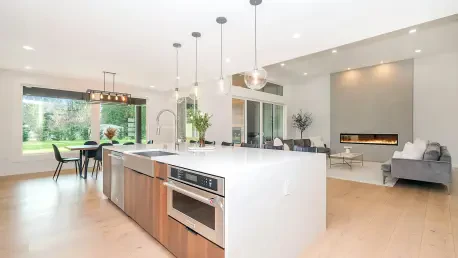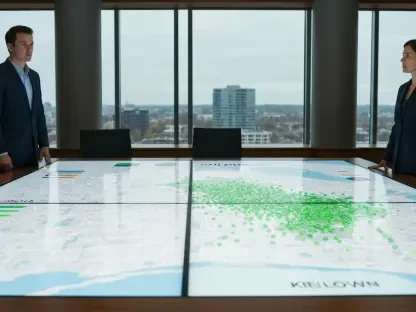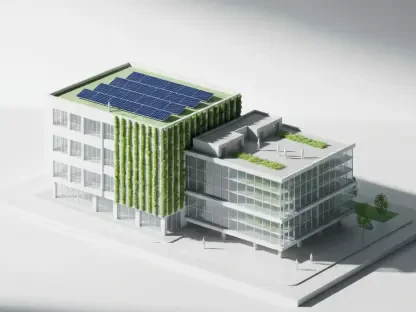In recent years, the use of Paragraph 84 of the National Planning Policy Framework (NPPF) by the wealthy has become increasingly popular for constructing modern, high-quality homes in the British countryside. This policy, originally designed to facilitate traditional country estates, is now being leveraged to create ultra-modern, multi-million-pound properties. Such developments, often featured on the Channel 4 program “Grand Designs,” are beginning to reshape the rural landscape in significant ways. These modern mansions are not only architectural marvels but also symbols of a growing trend that blends innovation with natural beauty.
Shift in Architectural Trends
The architectural landscape of Britain’s countryside is undergoing a noteworthy transformation, moving away from classic country estates to embrace contemporary, cutting-edge designs. This shift is exemplified by projects such as the Headlands in the Cotswold Area of Outstanding Natural Beauty and Swinhay House near Wotton-under-Edge, Gloucestershire. The Headlands, with its unique leaf-shaped zinc roof and state-of-the-art interior, represents a departure from traditional designs while still maintaining a strong connection to natural forms. Similarly, Swinhay House, featuring a futuristic design and a dramatic central lookout tower, brought modern architectural principles to the rural setting, even serving as the home for a character in the BBC hit “Sherlock.”
These examples reflect a broader trend in which high-end homes are designed with innovative aesthetics and technological sophistication. The evolution from traditional to contemporary styles is driven by a desire for visual distinction and the incorporation of modern amenities. The synergy between cutting-edge design and natural surroundings creates residences that are not only visually striking but also harmonize with their environments. This fusion is becoming increasingly sought-after by those looking to leave a distinctive mark on the countryside.
Key Figures and Influences
A key figure in this architectural evolution is Richard Hawkes, director and founder of Hawkes Architecture. Hawkes has played a pivotal role in developing homes under the Paragraph 84 exemption, overseeing a significant number of projects. He founded his firm after successfully building his own exceptional eco-friendly home in Kent under the predecessor policy to Paragraph 84. His work exemplifies the trend towards modern designs and has significantly influenced the popularity of these homes, thanks in part to their regular features on “Grand Designs.”
According to Hawkes, the policy has evolved considerably, shifting its focus from traditional English country homes to contemporary projects that push the boundaries of modern architecture. He observes that “Grand Designs” has been instrumental in popularizing these innovative interpretations, creating a symbiotic relationship where the program serves as both a showcase and a source of inspiration. Architects like Hawkes are shaping the future of rural living by combining environmental sensitivity with avant-garde design principles, ensuring that these homes are both sustainable and visually appealing.
Rigorous Planning Process
Building a home under the Paragraph 84 exemption involves a stringent planning process that sets high standards for architectural quality and sensitivity to local contexts. The National Planning Policy Framework demands that these homes demonstrate exceptional quality, significantly enhance their immediate surroundings, and respect the defining characteristics of the area. This rigorous process not only ensures the preservation of the countryside’s integrity but also mandates that new constructions contribute positively to the landscape.
The costs involved in this planning process are substantial, starting at a minimum of £100,000, with overall project expenses often running into the millions. Factors such as the size of the house, the complexity of the design, and the materials used all contribute to the final cost. The investment is justified by the end product—a home that meets the highest architectural standards and blends seamlessly with its environment. This thorough and demanding process ensures that each Paragraph 84 home is not just another building but a statement of artistic and environmental excellence.
Notable Projects
Several notable projects have met the stringent Paragraph 84 criteria, showcasing unique architectural styles and historical connections to their locations. One example is Bigbury Hollow in Kent, a subterranean property near the Bigbury Camp Iron Age hillfort. This innovative design features two large terraced courtyards and underground wings, creating a home that integrates seamlessly with the surrounding landscape. Built for around £1.5 million, Bigbury Hollow was highlighted in the 23rd series of “Grand Designs” as an example of how modern architecture can reflect historical context while pushing design boundaries.
Another remarkable project is Lake House in East Sussex, designed to resemble three dramatic “carriages” nestled within trees. This design reflects the historical connection to the nearby former fishing lake and a derelict railway line. The Lake House stands as a testament to how modern homes can draw inspiration from their surroundings and historical significance, creating a narrative that resonates with the site’s past while looking forward. These projects serve as prime examples of the creativity and vision driving the development of Paragraph 84 homes.
Importance of Suitable Land and Collaboration
Rob Hughes, director of Hughes Planning, underscores the importance of selecting the right plot of land for a successful Paragraph 84 project. The choice of land is crucial, as it determines the feasibility and impact of the design. Hughes emphasizes the necessity of professional advice and a collaborative approach involving planning consultants, architects, landscape architects, ecologists, and other experts. This multidisciplinary collaboration ensures that every aspect of the project is carefully considered, from environmental impact to aesthetic appeal.
Hughes also identifies three common pitfalls that can cause applications to fail: inadequate enhancement of the area, failure to align with the area’s defining characteristics, and designs that are not sufficiently outstanding. Avoiding these pitfalls requires a thorough understanding of the local context and a commitment to excellence in design. Successful projects result from a balance of innovative thinking and respect for the landscape, ensuring that new homes contribute positively to the rural environment.
Addressing Community Concerns
The construction of modern mansions under Paragraph 84 has sparked concerns among local communities about potential changes to the rural landscape and the impact on traditional countryside aesthetics. Some argue that these ultra-modern homes may not always blend harmoniously with their surroundings, potentially disrupting the character of the area. Engaging with local communities and addressing their concerns is essential for the successful integration of these new developments. Transparent communication and collaboration with local stakeholders can help mitigate opposition and ensure that the benefits of these projects are widely recognized and appreciated.
The rise of these high-end homes represents a shift in how affluent individuals envision their blend of luxury and nature, potentially setting new standards in countryside housing.









